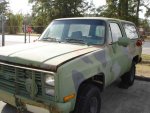-
Steel Soldiers now has a few new forums, read more about it at: New Munitions Forums!
M1009 Light Bar?
- Thread starter SandBar
- Start date

More options
Who Replied?Crash_AF
Active member
- 1,530
- 7
- 38
- Location
- Colorado Springs, CO
There was no 'standard' lightbar used by the military. We had Federal Signal Aerodynic, Federal Signal Jetsonic, and Whelen Edge lightbars on different trucks in the Air Force.
Later
Later
Thanks, I picked up this one for a real good price and plan to mount it up. It has 4 spinners, and I will paint the center section OD. Looking for a light bar / siren controller now. I was thinking about extending my upcoming safari rack project so the rack extends over the cab. That way I could mount the light bar to the rack and not the cab (I don't need more areas to rust/leak). Where the light bars you saw amber or other colors?
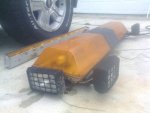

Crash_AF
Active member
- 1,530
- 7
- 38
- Location
- Colorado Springs, CO
Depended on the job. Our barrier maintenance trucks had red or Red/yellow bars on them. Maintenance only trucks had amber.
We had those bars too. Streethawk I think those were called? Anyway, you should be able to find some driprail mounts to put it on the truck without drilling into the cab. You can drill into the rear cap instead of the cab for the cable.
Later
We had those bars too. Streethawk I think those were called? Anyway, you should be able to find some driprail mounts to put it on the truck without drilling into the cab. You can drill into the rear cap instead of the cab for the cable.
Later
I am planning on building a safari rack (good mig practice for this welding noob). I want the safari rack to have brackets that extend forward from the cap 2-3 ft to allow for light bar and utility lights. I am about to go outside and play with the light bar a little. I have a red one too if anyone needs one.
K9Vic
Active member
- 1,261
- 7
- 38
- Location
- Fort Worth, TX
The only light that I believe was a standard design specifically for the M1009 was a rear strobe beacon mounted to one of the antenna mounts. It has all the standard wiring connectors used for military vehicles and was 24v. The switch for it was in the rear next to the tailgate, so it could not be turned off without stopping and getting out.
Here are pictures of it.
Here are pictures of it.
Attachments
-
31.5 KB Views: 66
-
36.8 KB Views: 79
-
31 KB Views: 70
- 1,487
- 1,640
- 113
- Location
- Puget Sound, WA
I modded a Whelen Edge lightbar for mine. I modified the reflector cups to accept some 35 watt HIDs. Here's the set-up:
Six forward facing 35 watt HIDs
Two 55 watt halogen bulbs in the angled reflectors
Two 55 watt alley lights
The entire front of the bar has clear lenses
To the rear, I have two banks of amber LEDs through amber lenses- these will flash/strobe in various patterns
On the grille are two 450 watt aircraft landing lights
All of this is controlled by the Federal Signal SW300
For noise making purposes, I have a police siren set to run the air-horn function with one 100 watt speaker over the lightbar, and one 100 watt speaker on the grille.
Big pic: http://www.topohiker.com/news/newspics/LLa.png

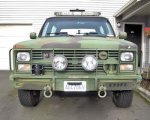
Six forward facing 35 watt HIDs
Two 55 watt halogen bulbs in the angled reflectors
Two 55 watt alley lights
The entire front of the bar has clear lenses
To the rear, I have two banks of amber LEDs through amber lenses- these will flash/strobe in various patterns
On the grille are two 450 watt aircraft landing lights
All of this is controlled by the Federal Signal SW300
For noise making purposes, I have a police siren set to run the air-horn function with one 100 watt speaker over the lightbar, and one 100 watt speaker on the grille.
Big pic: http://www.topohiker.com/news/newspics/LLa.png


Last edited:
ThunderCracker
Member
- 665
- 7
- 18
- Location
- Madison Alabama
Looks cool!
on1wheel01
New member
- 78
- 0
- 0
- Location
- Mooresville nc
Wow that looks great. I wonder if it is legal in nc
Here are the details for your state:Wow that looks great. I wonder if it is legal in nc
[h=2]North Carolina[/h]
§ 20‑130.1. Use of red or blue lights on vehicles prohibited; exceptions.
(a) It is unlawful for any person to install or activate or operate a red light in or on any vehicle in this State. As used in this subsection, unless the context requires otherwise, "red light" means an operable red light not sealed in the manufacturer's original package which: (i) is designed for use by an emergency vehicle or is similar in appearance to a red light designed for use by an emergency vehicle; and (ii) can be operated by use of the vehicle's battery, vehicle's electrical system, or a dry cell battery. As used in this subsection, the term "red light" shall also mean any forward facing red light installed on a vehicle after initial manufacture of the vehicle.
(b) The provisions of subsection (a) of this section do not apply to the following:
(1) A police car;
(2) A highway patrol car;
(3) A vehicle owned by the Wildlife Resources Commission and operated exclusively for law‑enforcement purposes;
(4) An ambulance;
(5) A vehicle used by an organ procurement organization or agency for the recovery and transportation of blood, human tissues, or organs for transplantation;
(6) A fire‑fighting vehicle;
(7) A school bus;
( A vehicle operated by any member of a municipal or rural fire department in the performance of his duties, regardless of whether members of that fire department are paid or voluntary;
A vehicle operated by any member of a municipal or rural fire department in the performance of his duties, regardless of whether members of that fire department are paid or voluntary;
(9) A vehicle of a voluntary lifesaving organization (including the private vehicles of the members of such an organization) that has been officially approved by the local police authorities and which is manned or operated by members of that organization while answering an official call;
(10) A vehicle operated by medical doctors or anesthetists in emergencies;
(11) A motor vehicle used in law enforcement by the sheriff, or any salaried rural policeman in any county, regardless of whether or not the county owns the vehicle;
(11a) A vehicle operated by the State Fire Marshal or his representatives in the performance of their duties, whether or not the State owns the vehicle;
(12) A vehicle operated by any county fire marshal, assistant fire marshal, or emergency management coordinator in the performance of his duties, regardless of whether or not the county owns the vehicle;
(13) A light required by the Federal Highway Administration;
(14) A vehicle operated by a transplant coordinator who is an employee of an organ procurement organization or agency when the transplant coordinator is responding to a call to recover or transport human tissues or organs for transplantation;
(15) A vehicle operated by an emergency medical service as an emergency support vehicle;
(16) A State emergency management vehicle; and
(17) An Incident Management Assistance Patrol vehicle operated by the Department of Transportation, when using rear‑facing red lights while stopped for the purpose of providing assistance or incident management.
(c) It is unlawful for any person to possess a blue light or to install, activate, or operate a blue light in or on any vehicle in this State, except for a publicly owned vehicle used for law enforcement purposes or any other vehicle when used by law enforcement officers in the performance of their official duties. As used in this subsection, unless the context requires otherwise, "blue light" means any forward facing blue light installed on a vehicle after initial manufacture of the vehicle; or an operable blue light which:
(1) Is not (i) being installed on, held in inventory for the purpose of being installed on, or held in inventory for the purpose of sale for installation on a vehicle on which it may be lawfully operated or (ii) installed on a vehicle which is used solely for the purpose of demonstrating the blue light for sale to law enforcement personnel;
(1a) Is designed for use by an emergency vehicle, or is similar in appearance to a blue light designed for use by an emergency vehicle; and
(2) Can be operated by use of the vehicle's battery, the vehicle's electrical system, or a dry cell battery.
(c1) The provisions of subsection (c) of this section do not apply to the possession and installation of an inoperable blue light on a vehicle that is inspected by and registered with the Department of Motor Vehicles as a specially constructed vehicle and that is used primarily for participation in shows, exhibitions, parades, or holiday/weekend activities, and not for general daily transportation. For purposes of this subsection, "inoperable blue light" means a blue‑colored lamp housing or cover that does not contain a lamp or other mechanism having the ability to produce or emit illumination.
(d) Repealed by Session Laws 1999‑249, s. 1.
(e) Violation of subsection (a) or (c) of this section is a Class 1 misdemeanor. (1943, c. 726; 1947, c. 1032; 1953, c. 354; 1955, c. 528; 1957, c. 65, s. 11; 1959, c. 166, s. 2; c. 1170, s. 2; 1967, c. 651, s. 1; 1971, c. 1214; 1977, c. 52, s. 2; c. 438, s. 2; 1979, c. 653, s. 1; c. 887; 1983, c. 32, s. 1; c. 768, s. 6; 1985 (Reg. Sess., 1986), c. 1027, s. 50; 1989, c. 537, s. 2; 1989 (Reg. Sess., 1990), c. 1020, s. 2; 1991, c. 263, s. 1; 1993, c. 539, s. 361; 1994, Ex. Sess., c. 24, s. 14(c); 1993 (Reg. Sess., 1994), c. 719, s. 1; 1995, c. 168, s. 1; 1995 (Reg. Sess., 1996), c. 756, s. 16; 1999‑249, s. 1; 2005‑152, s. 1; 2009‑526, s. 1; 2009‑550, s. 3; 2010‑132, s. 11.)
§ 20‑130.2. Use of amber lights on certain vehicles.
All wreckers operated on the highways of the State shall be equipped with an amber‑colored flashing light which shall be so mounted and located as to be clearly visible in all directions from a distance of 500 feet, which light shall be activated when at the scene of an accident or recovery operation and when towing a vehicle which has a total outside width exceeding 96 inches or which exceeds the width of the towing vehicle. It shall be lawful to equip any other vehicle with a similar warning light including, but not by way of limitation, maintenance or construction vehicles or equipment of the Department of Transportation engaged in performing maintenance or construction work on the roads, maintenance or construction vehicles of any person, firm or corporation, Radio Emergency Associated Citizens Team (REACT) vehicles, and any other vehicles required to contain a warning light. (1967, c. 651, s. 2; 1973, c. 507, s. 5; 1977, c. 464, s. 34; 1979, c. 1; c. 765; 1981, c. 390; 1991, c. 44, s. 1.)
§ 20‑130.3. Use of white or clear lights on rear of vehicles prohibited; exceptions.
It shall be unlawful for any person to willfully drive a motor vehicle in forward motion upon the highways of this State displaying white or clear lights on the rear of said vehicle. The provisions of this section shall not apply to the white light required by G.S. 20‑129(d) or so‑called backup lights lighted only when said vehicle is in reverse gear or backing. Violation of this section does not constitute negligence per se in any civil action. (1973, c. 1071.)
It is routinely stated that Wig-wags/modulated headlights are illegal in the state of North Carolina. This is the only documentation that I can find pertaining to modulated headlights, and while it does not specifically prohibit it, it does not say you can have them either. I'm not a law student, so draw your own conclusions or consult a lawyer.
§ 20‑130. Additional permissible light on vehicle.
(d) Electronically Modulated Headlamps. – Nothing contained in this Chapter shall prohibit the use of electronically modulated headlamps on motorcycles, law‑enforcement and fire department vehicles, county fire marshals and Emergency Management coordinators, public and private ambulances, and rescue squad emergency service vehicles, provided such headlamps and light modulator are of a type or kind which have been approved by the Commissioner of Motor Vehicles.
(a) It is unlawful for any person to install or activate or operate a red light in or on any vehicle in this State. As used in this subsection, unless the context requires otherwise, "red light" means an operable red light not sealed in the manufacturer's original package which: (i) is designed for use by an emergency vehicle or is similar in appearance to a red light designed for use by an emergency vehicle; and (ii) can be operated by use of the vehicle's battery, vehicle's electrical system, or a dry cell battery. As used in this subsection, the term "red light" shall also mean any forward facing red light installed on a vehicle after initial manufacture of the vehicle.
(b) The provisions of subsection (a) of this section do not apply to the following:
(1) A police car;
(2) A highway patrol car;
(3) A vehicle owned by the Wildlife Resources Commission and operated exclusively for law‑enforcement purposes;
(4) An ambulance;
(5) A vehicle used by an organ procurement organization or agency for the recovery and transportation of blood, human tissues, or organs for transplantation;
(6) A fire‑fighting vehicle;
(7) A school bus;
(
(9) A vehicle of a voluntary lifesaving organization (including the private vehicles of the members of such an organization) that has been officially approved by the local police authorities and which is manned or operated by members of that organization while answering an official call;
(10) A vehicle operated by medical doctors or anesthetists in emergencies;
(11) A motor vehicle used in law enforcement by the sheriff, or any salaried rural policeman in any county, regardless of whether or not the county owns the vehicle;
(11a) A vehicle operated by the State Fire Marshal or his representatives in the performance of their duties, whether or not the State owns the vehicle;
(12) A vehicle operated by any county fire marshal, assistant fire marshal, or emergency management coordinator in the performance of his duties, regardless of whether or not the county owns the vehicle;
(13) A light required by the Federal Highway Administration;
(14) A vehicle operated by a transplant coordinator who is an employee of an organ procurement organization or agency when the transplant coordinator is responding to a call to recover or transport human tissues or organs for transplantation;
(15) A vehicle operated by an emergency medical service as an emergency support vehicle;
(16) A State emergency management vehicle; and
(17) An Incident Management Assistance Patrol vehicle operated by the Department of Transportation, when using rear‑facing red lights while stopped for the purpose of providing assistance or incident management.
(c) It is unlawful for any person to possess a blue light or to install, activate, or operate a blue light in or on any vehicle in this State, except for a publicly owned vehicle used for law enforcement purposes or any other vehicle when used by law enforcement officers in the performance of their official duties. As used in this subsection, unless the context requires otherwise, "blue light" means any forward facing blue light installed on a vehicle after initial manufacture of the vehicle; or an operable blue light which:
(1) Is not (i) being installed on, held in inventory for the purpose of being installed on, or held in inventory for the purpose of sale for installation on a vehicle on which it may be lawfully operated or (ii) installed on a vehicle which is used solely for the purpose of demonstrating the blue light for sale to law enforcement personnel;
(1a) Is designed for use by an emergency vehicle, or is similar in appearance to a blue light designed for use by an emergency vehicle; and
(2) Can be operated by use of the vehicle's battery, the vehicle's electrical system, or a dry cell battery.
(c1) The provisions of subsection (c) of this section do not apply to the possession and installation of an inoperable blue light on a vehicle that is inspected by and registered with the Department of Motor Vehicles as a specially constructed vehicle and that is used primarily for participation in shows, exhibitions, parades, or holiday/weekend activities, and not for general daily transportation. For purposes of this subsection, "inoperable blue light" means a blue‑colored lamp housing or cover that does not contain a lamp or other mechanism having the ability to produce or emit illumination.
(d) Repealed by Session Laws 1999‑249, s. 1.
(e) Violation of subsection (a) or (c) of this section is a Class 1 misdemeanor. (1943, c. 726; 1947, c. 1032; 1953, c. 354; 1955, c. 528; 1957, c. 65, s. 11; 1959, c. 166, s. 2; c. 1170, s. 2; 1967, c. 651, s. 1; 1971, c. 1214; 1977, c. 52, s. 2; c. 438, s. 2; 1979, c. 653, s. 1; c. 887; 1983, c. 32, s. 1; c. 768, s. 6; 1985 (Reg. Sess., 1986), c. 1027, s. 50; 1989, c. 537, s. 2; 1989 (Reg. Sess., 1990), c. 1020, s. 2; 1991, c. 263, s. 1; 1993, c. 539, s. 361; 1994, Ex. Sess., c. 24, s. 14(c); 1993 (Reg. Sess., 1994), c. 719, s. 1; 1995, c. 168, s. 1; 1995 (Reg. Sess., 1996), c. 756, s. 16; 1999‑249, s. 1; 2005‑152, s. 1; 2009‑526, s. 1; 2009‑550, s. 3; 2010‑132, s. 11.)
§ 20‑130.2. Use of amber lights on certain vehicles.
All wreckers operated on the highways of the State shall be equipped with an amber‑colored flashing light which shall be so mounted and located as to be clearly visible in all directions from a distance of 500 feet, which light shall be activated when at the scene of an accident or recovery operation and when towing a vehicle which has a total outside width exceeding 96 inches or which exceeds the width of the towing vehicle. It shall be lawful to equip any other vehicle with a similar warning light including, but not by way of limitation, maintenance or construction vehicles or equipment of the Department of Transportation engaged in performing maintenance or construction work on the roads, maintenance or construction vehicles of any person, firm or corporation, Radio Emergency Associated Citizens Team (REACT) vehicles, and any other vehicles required to contain a warning light. (1967, c. 651, s. 2; 1973, c. 507, s. 5; 1977, c. 464, s. 34; 1979, c. 1; c. 765; 1981, c. 390; 1991, c. 44, s. 1.)
§ 20‑130.3. Use of white or clear lights on rear of vehicles prohibited; exceptions.
It shall be unlawful for any person to willfully drive a motor vehicle in forward motion upon the highways of this State displaying white or clear lights on the rear of said vehicle. The provisions of this section shall not apply to the white light required by G.S. 20‑129(d) or so‑called backup lights lighted only when said vehicle is in reverse gear or backing. Violation of this section does not constitute negligence per se in any civil action. (1973, c. 1071.)
It is routinely stated that Wig-wags/modulated headlights are illegal in the state of North Carolina. This is the only documentation that I can find pertaining to modulated headlights, and while it does not specifically prohibit it, it does not say you can have them either. I'm not a law student, so draw your own conclusions or consult a lawyer.
§ 20‑130. Additional permissible light on vehicle.
(d) Electronically Modulated Headlamps. – Nothing contained in this Chapter shall prohibit the use of electronically modulated headlamps on motorcycles, law‑enforcement and fire department vehicles, county fire marshals and Emergency Management coordinators, public and private ambulances, and rescue squad emergency service vehicles, provided such headlamps and light modulator are of a type or kind which have been approved by the Commissioner of Motor Vehicles.
detroitdiesel4x4
New member
- 60
- 0
- 0
- Location
- Piney Hicks N.J
Does anybody know where to get a screen for these things? Like a little cage to go around the light bar to protect it from tree branches and overhead obstacles? I'm looking to get a code3 mx7000 mounted to the roof with alley lights on the side and a-pillar spotlights all painted to match
Crash_AF
Active member
- 1,530
- 7
- 38
- Location
- Colorado Springs, CO
More details on the mods to the Edge please. I have a couple of Edge bars that I'm interested in modding like that.I modded a Whelen Edge lightbar for mine. I modified the reflector cups to accept some 35 watt HIDs. Here's the set-up:
Six forward facing 35 watt HIDs
Two 55 watt halogen bulbs in the angled reflectors
Two 55 watt alley lights
The entire front of the bar has clear lenses
To the rear, I have two banks of amber LEDs through amber lenses- these will flash/strobe in various patterns
On the grille are two 450 watt aircraft landing lights
All of this is controlled by the Federal Signal SW300
Thanks
- 1,487
- 1,640
- 113
- Location
- Puget Sound, WA
It's a somewhat lengthy description for a relatively short process. I started by stripping everything out of the bar and cleaning it up good. I painted the top OD green.More details on the mods to the Edge please. I have a couple of Edge bars that I'm interested in modding like that.
Thanks
Then I took a hacksaw blade and carefully cut the very top of the reflector cups off (it has three notches to accept the Whelen bulbs). Then I laid the HID bulb (#9145) in the cup and rotated it around so that I found a configuration that had the bulb sitting square in the hole (because it gets slightly off-square cutting with the hacksaw blade) and marked it. Then I epoxied the bulb down with just a little epoxy so that I can dremel it off and glue down a new one if it ever burns out.
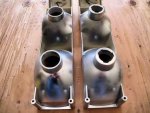

In the corners the reflector angles back, so I just drilled a 1" hole in the center and mounted the H3 bulb cups I cannibalized from a set of cheap off-road lights. They sit back far enough that the heat from the bulb won't discolor the lens.
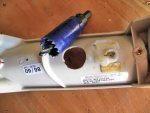
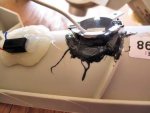
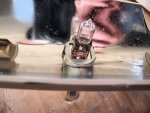
Once I had all the bulbs in the cups, I used mounting tape to mount the HID ballasts to the back side of the bar and ran the wires through the through-holes to the bulbs. All the lights and ballasts are wired to the topside of a junction (see the picture), so once that was done all I needed to do was build a cable to go up through the roof and through the hole in the bottom of the lightbar. I didn't have a pre-made cable with my bar, and I wanted to run heavier wire to the lights with the big loads. I made the cable by attaching the appropriate wire to the bottom of the junction, then wrapped it with 1" split loom, which I covered with some big heat-shrink I had around. The fit where it passes through the roof of the cab is tight enough that it's sealed without silicone.

Inside the cab I have the wires running to a Federal Signal SW300 configured thusly: The first switch on the box is set up to run a large load, so four of the six HIDs are powered from that, then two more HIDs on the second switch. The third switch runs the halogen bulbs in the corners, the fourth runs both alley lights, the fifth turns on the amber flashers on the rear of the bar, and the sixth switch runs the solenoid that switches power for the landing lights on the grille.
Last edited:
- 1,653
- 1,669
- 113
- Location
- Nova Laboratories, WA
The most popular lightbar was the AeroDynic, as it was popular at the time the m1009/cucv was around.
Later models got the Jetstream/Jetsonic, as they were more expensive with more features, they were rarer, in addition to coming in at a later time, Vs the AeroDynic which had been available for years.
The edge came out later than the Jetstream/Jetsonic, as both the aerodynic and the Jetstream/jetsonic were rotator lightbars, and the Edge9000 was a 'new' strobe lightbar (at the time) and even MORE expensive than the Jetsonic.
Aerodynic
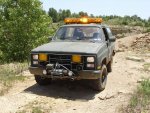
Jetsonic
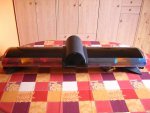
Jetstream (Jetsonic without speaker)
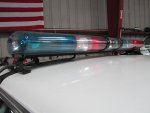
Edge9000 WITH SA40 speaker

Edge9000

For a vintage/period correct build, DEFINITELY get an AeroDynic, no questions asked.
You could go for a jetsonic/jetstream, if you had a later model year.
Mainsail and I chose Edge 9000s because they're modular, easy to wire, easy to modify, etc etc. We both have very similar setups, despite building ours separately. Great minds think alike.
But they're not my first choice for a period correct piece, as the Edge 9000 was introduced in 1983, super expensive, and not mainstream until the late 80's early 90's.
If you do get an AeroDynic, you will need roof insulation, they make a god awful noise when in operation, loud as heck.
Later models got the Jetstream/Jetsonic, as they were more expensive with more features, they were rarer, in addition to coming in at a later time, Vs the AeroDynic which had been available for years.
The edge came out later than the Jetstream/Jetsonic, as both the aerodynic and the Jetstream/jetsonic were rotator lightbars, and the Edge9000 was a 'new' strobe lightbar (at the time) and even MORE expensive than the Jetsonic.
Aerodynic

Jetsonic

Jetstream (Jetsonic without speaker)

Edge9000 WITH SA40 speaker

Edge9000

For a vintage/period correct build, DEFINITELY get an AeroDynic, no questions asked.
You could go for a jetsonic/jetstream, if you had a later model year.
Mainsail and I chose Edge 9000s because they're modular, easy to wire, easy to modify, etc etc. We both have very similar setups, despite building ours separately. Great minds think alike.
But they're not my first choice for a period correct piece, as the Edge 9000 was introduced in 1983, super expensive, and not mainstream until the late 80's early 90's.
If you do get an AeroDynic, you will need roof insulation, they make a god awful noise when in operation, loud as heck.
Crash_AF
Active member
- 1,530
- 7
- 38
- Location
- Colorado Springs, CO
Of course, all of this is dependent on what you want. 'Period Correct' spans 20 years of service life. All of those bars were available throughout their period of service, so they are technically correct. And as far as cost goes, when has the military ever worried about cost? LOL
And yes, the Aerodynic geartrain is god-awfully loud. We had one on our big service truck (1.5 ton International) and you could hear it over the diesel.
And yes, the Aerodynic geartrain is god-awfully loud. We had one on our big service truck (1.5 ton International) and you could hear it over the diesel.
- 110,655members
- 165,172threads
- 2,324,098posts
- 1,440online users



